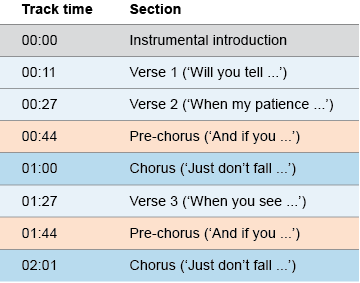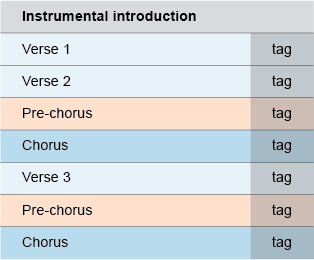8 The pre-chorus
In contemporary pop songs, a verse often moves to a chorus by way of a pre-chorus. Like the chorus, the pre-chorus tends to make use of the same words and the same melody each time it is heard. Nonetheless, it can be distinguished from the chorus in that it helps to effect a transition to the chorus from the verse, and in that the chorus usually remains the most memorable and expressive section of the song. A good example of a pre-chorus can be heard in Robyn’s performance of Klas Åhlund’s ‘Hang with Me’ (Åhlund, 2010), the focus of the next activity. As Table 6 shows, following a brief instrumental introduction, listeners hear the first verse, the second verse, the pre-chorus, and then the chorus proper.
| Track time | Section |
|---|---|
| 00:00 | Instrumental introduction |
| 00:11 | Verse 1 (‘Will you tell me ...’) |
| 00:27 | Verse 2 (‘When my patience ...’) |
| 00:44 | Pre-chorus (‘And if you ...’) |
| 01:00 | Chorus (‘Just don’t fall ...’) |
Activity 5
This activity has three parts.
Part A
Listen several times to the first 01:27 of Robyn’s ‘Hang with Me’, following the form with the help of Table 6, until you can tell the difference between the verses, the pre-chorus and the chorus.
Part B
Now attempt to determine what happens between 01:27 and 02:30 (this isn’t shown in Table 6). Do any of the earlier sections of the song recur? As you listen, write down a few notes about the material between 01:27 and 02:30 – for instance the lyrics and track time from the beginning of anything that sounds like the beginning of a section. Don’t worry if you find it difficult to hear the form clearly on the first listen; this often becomes clearer in retrospect, after you have heard the music more than once. It will probably be helpful to move back and forth within the track, comparing the beginnings of sections directly with one another.
a.
the pre-chorus
b.
the first verse
c.
a bridge
d.
the chorus
e.
a new verse
The correct answer is e.
a.
the chorus
b.
the second verse
c.
the pre-chorus
d.
a bridge
e.
a new verse
The correct answer is c.
a.
a bridge
b.
a new verse
c.
the chorus
d.
the second verse
e.
the pre-chorus
The correct answer is c.
Discussion
The organisation of the opening 02:30 of ‘Hang with Me’ is summarised in Figure 8; each kind of section – introduction, verse, pre-chorus, chorus – has its own colour. The structure from 00:11 to 01:27 (Verse 1, Verse 2, pre-chorus, chorus) is very similar to that from 01:27 to 02:30 (Verse 3, pre-chorus, chorus). The only difference is that from 01:27 to 02:30, there is one verse, rather than two.
Figure 8 also helps clarify a number of things about pre-choruses that distinguish them from bridges (in case some of these terms are starting to blur together!): a pre-chorus is introduced relatively early in a song, it functions as a ‘connector’ between verse and chorus, and it is more likely than a bridge to occur more than once.
The outline in Figure 8 does not account for every element of formal interest in ‘Hang with Me’. If you listen to the song closely, you should be able to hear that each section ends with a similar concluding formula. This occurs in a slightly different way each time: as ‘Then I guess you can hang with me’ in the verses, ‘If you hang with me’ in the pre-choruses, and ‘You can hang with me’ in the choruses. But the same words are always sung to the same melody. Figure 9 represents this feature by means of the word ‘tag’ near the right side of the row representing each section.


